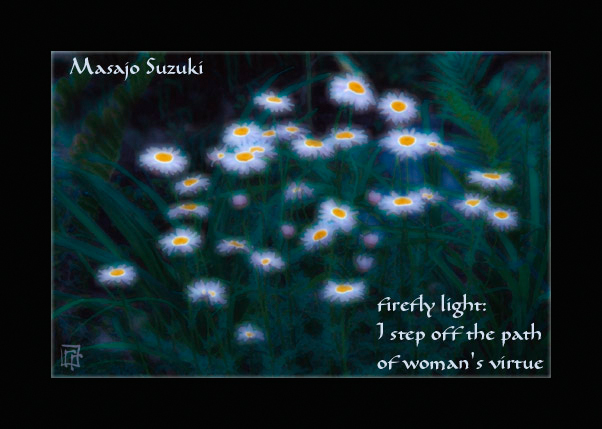The following are brief definitions and examples of the English-language haiku genres: haiku, senryu, haibun, haiga and tanka.
For more comprehensive definitions of these forms, see:
 the Haiku Society of America Definitions, the Haiku Society of America Definitions,
 the Tanka Society of American Definitions the Tanka Society of American Definitions
 Stephen Addiss' "A Brief History of Haiga." Stephen Addiss' "A Brief History of Haiga."
 Haiku: A haiku is a short poem that uses descriptive langage to convey the essence of a human experience wherever that may occur. Haiku: A haiku is a short poem that uses descriptive langage to convey the essence of a human experience wherever that may occur.
Haiku Example:
spring sun
cedar waxwings fill
the leafless plum
(published in The Heron's Nest)
Most modern English-language haiku consist of three lines with two phrases whose connection forums the spark of this poetic form.
In this haiku, the writer was taking a walk in early spring and for the first time feeling the sun's warmth on his shoulders. On that walk he noticed a flock of cedar waxwings feeding on the small plums of a tree that had not yet sprouted leaves. Cedar waxwings make a singing-humming noise when feeding on the leftover fruits of various trees, and even get high from the fermantation that takes place. The experience of the tree being filled with song and birds feeling a bit drunken is being likened to his feelings with warmth of sun on his shoulders for the first time in months.
In the Japanese language, haiku have 17 sound units aranged in three 5-7-5 lines. Modern English-language haiku has evolved into its own related, but distinct form. They average 13 syllables which roughly corresponds to 17 Japanese-language sound units.
- Line 1 (spring sun) is a distinct phrase. It's 'clipped' in that it has no articles or verbs.
- Lines 2 and 3 (cedar waxwings fill the leafless plum) comprise a second distinct phrase. It's a more complete phrase with a subject, verb, article, noun and adjective.
spring sun = 2 syllables
cedar waxwings fill = 5 syllables
the leafless plum = 4 syllables
There is a natural break between line 1 and lines 2/3 because it doesn't make make sense to read "spring sun cedar waxwings fill ..." without a break. That break and the natural pause it causes when reading the haiku constitutes the equivalent of 1 syllable.
Some writers use dashes, en-dsahes, em-dashes, ellipses and commas to indiate the break between the two phrases. Thus, the haiku above could be written:
spring sun –
cedar waxwings fill
the leafless plum
There is a great variation in published haiku with respect to syllable counts, lineage and phrasing. Syllable counts range from very few to 17 and there are 1, 2 and 4-line haiku published in haiku-genre journals. Most haiku don't use capitals at the start of the lines, but some writers do use them. To explore the variation and read more haiku, refer to these two websites:
 The Heron's Nest (an online journal dedicated to haiku) The Heron's Nest (an online journal dedicated to haiku)
 A Hundred Gourds (an online journal with a large haiku section) A Hundred Gourds (an online journal with a large haiku section)
 Senryu: A related form is Senryu, a poem that is structurally similar to haiku and with a focus on human situations and that typically employs humour or satire. Senryu: A related form is Senryu, a poem that is structurally similar to haiku and with a focus on human situations and that typically employs humour or satire.
Senryu Example:
meditation class . . .
he begins by comtemplating
the blonde's navel
(published in Simply Haiku)
 Haibun: A haibun is a mix of prose and one or more haiku. The title, prose and haiku work together to form the spark of this form. The prose is typically succinct, almost haiku-like. The focus of the prose can be on a travel experience or a smaller, more discrete human experience. Some modern writers include fantasy, dreams, remembrances as their subjects. A related form is Tanka Prose, which is a mix of prose and one or more tanka poems (and sometimes mixed with haiku poems). Haibun: A haibun is a mix of prose and one or more haiku. The title, prose and haiku work together to form the spark of this form. The prose is typically succinct, almost haiku-like. The focus of the prose can be on a travel experience or a smaller, more discrete human experience. Some modern writers include fantasy, dreams, remembrances as their subjects. A related form is Tanka Prose, which is a mix of prose and one or more tanka poems (and sometimes mixed with haiku poems).
Example:
Warmth
I miss them, my daughters when they were young. Reading The Hobbit in wintertime, snuggled in close, bodies and fire keeping us warm, rewarded with their pleas . . . just one more page, please Dad!
I've nearly forgotten my reluctance to pick up the book in the first place.
I don't remember being read to, but when I was sick, my mother sang lullabies while tucking me deep under the covers, only my nose and ears sticking out. I remember the melodies, but not the words.
old friends—
I place more wood
on the campfire
(haibun published in Modern Haiku)
 Haiga: Modern haiga are a mix of image and haiku poetry. The haiku may be placed on or next to the image. Haiga artists utilize a variety of mediums: drawings, paintings, photography and digital-art. Just as the haiku in haibun serves as a link to and contrast with the prose in a haibun, so does the haiku in haiga compositions work to create the spark that makes haiga work and that differentiates it from pure artwork. Haiga: Modern haiga are a mix of image and haiku poetry. The haiku may be placed on or next to the image. Haiga artists utilize a variety of mediums: drawings, paintings, photography and digital-art. Just as the haiku in haibun serves as a link to and contrast with the prose in a haibun, so does the haiku in haiga compositions work to create the spark that makes haiga work and that differentiates it from pure artwork.
Example: haiku by Masajo Suzuki, composition and digital artwork by Ray Rasmussen.

 Tanka: A tanka is a short 5-line poem. Most modern English language tanka consist of 31 or fewer syllables which compares to the Japanese form of 5/7/5/7/7 Japanese sound units. Modern English language writers may or may not follow a short/long/short/long/long pattern. Tanka: A tanka is a short 5-line poem. Most modern English language tanka consist of 31 or fewer syllables which compares to the Japanese form of 5/7/5/7/7 Japanese sound units. Modern English language writers may or may not follow a short/long/short/long/long pattern.
Example:
I let it go
the brittle fury of
bright confetti
that will now be
nobody's letter
Jeffrey Woodward, The Pebbled Shore: Tanka Society of America Anthology 2009

|

